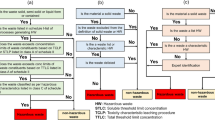Abstract
A novel approach for waste load allocation, namely, waste load scheduling, following the concept of machine scheduling has been developed and applied to a case study. The conceptual development and mathematical formulation for the waste load scheduling model has been discussed in the companion paper. The focus of this paper is to identify a suitable solution technique for solving the waste load scheduling model and then apply it to a case study river system in Tamil Nadu, India. The mathematical formulation for the waste load scheduling model was developed by treating it in an analogous way to a machine scheduling problem (as explained in the companion paper). Dynamic programming (DP) has been used by several researchers for solving such machine scheduling and sequencing problems and thus the same method is adopted here for solving the proposed waste load scheduling problem. To demonstrate the practical application of the proposed method, the model was applied to a real case study river system, namely, Thambraparani river system, which is located in the southern part of the Tamil Nadu state in India. The results from the waste load scheduling model proved that the method is very effective in reducing the total waste load discharge into the river and thereby achieving a high level of river water quality. Comparing the results of waste load scheduling (WLS) model with SEDP (Seasonal Effluent Discharge program) and EBP (Effluent By-Pass Piping) model shows that the proposed WLS model satisfies all the three water quality management goals (i.e., cost minimization, minimizing overall inequity, and minimizing total waste load discharge into the river) to a greater degree when compared to SEDP and EBP models.




Similar content being viewed by others
References
Annual Report on Air and Water Quality Network (2003), Central Pollution Control Board, New Delhi, India
Becker L, Yeh WW-G (1974) Optimization of real-time operation of a multiple reservoir system. Water Resour Res 10(6):1107–1112
Boner MC, Furland LP (1982) Seasonal treatment and variable effluent quality based on assimilative capacity. J Water Pollut Control Fed 54(10):1408–1416
Burn DH, Yulianti JS (2001) Waste load allocation using genetic algorithm. J Water Resour Plan Manag 127(2):121–129
Cardwell H, Ellis H (1993) Stochastic dynamic programming models for water quality management. Water Resour Res 29(4):803–813
Chang S, Yeh WW-G (1973) Optimal allocation of artificial aeration along a polluted stream using dynamic programming. J Am Water Resour Assoc 9(5):985–997
Cheng TCE, Sin CCS (1990) A state of the art review of parallel machine scheduling research. Eur J Oper Res 47(3):271–292
Graves GW, Hatfield GB, Whinston AB (1969) Water pollution control using by-pass piping. Water Resour Res 5:13–47
Hall WA, Butcher WS, Esogbue A (1968) Optimization of the operation of a multi-purpose reservoir by dynamic programming. Water Resour Res 4(3):471–477. doi:10.1029/WR004i003p00471
Heidari M, Chow VT, Kokotovic PV, Meredith DD (1971) Discrete differential dynamic programming approach to water resources systems optimization. Water Resour Res 7(2):273–282. doi:10.1029/WR007i002p00273
Jha M, Gu R (2010) Risk analysis of seasonal stream water quality management. Water Sci Technol 62(9):2075–2082
Larson RE, Keckler WG (1969) Applications of dynamic programming to the control of water resources systems. Automatica 5(1):15–26
Lence BJ, Eheart JW, Brill Jr ED (1990) Risk equivalent seasonal discharge programs for multidischarger streams. J Water Resour Plan Manag 116(2):170–186
Liebmann JC, Lynn WR (1966) The optimal allocation of stream dissolved oxygen. Water Resour Res 2(3):581–591. doi:10.1029/WR002i003p00581
McCarthy BL, Liu J (1993) Addressing the gap in scheduling research: a review of optimization and heuristic methods in production scheduling. Int J Prod Res 33(1):59–79
Mujumdar PP, Saxena P (2004) A stochastic dynamic programming model for stream water quality management. Sadhana 29(5):477–497
Murty YSR, Sreenivasan K, Murthy BS (2006) Multiobjective optimal waste load allocation models for rivers using non-dominated sorting genetic algorithm-II. J Water Resour Plan Manag 132(3):133–143
Ng AWM, Perera BJC, Tran DH (2006) Improvement of river water quality through a seasonal effluent discharge program (SEDP). Water Air Soil Pollut 176:113–137
Reheis HF, Dozier J, Word D, Holland J (1982) Treatment costs savings through monthly variable effluent limits. J Water Pollut Control Fed 54(8):1224–1230
Rossman LA (1989) Risk equivalent seasonal waste load allocation. Water Resour Res 25(10):2083–2090
Sato N, Okubo T, Onodera T, Agarwal LK, Ohashi A, Harada H (2007) Economic evaluation of sewage treatment processes in India. J Environ Manag 84(4):447–460
Shih CS, Krishnan P (1969) Dynamic optimization for industrial waste treatment design. J Water Pollut Control Fed 41(10):1787–1802
Sunantara JD, Ramirez JA (1997) Optimal stochastic multicrop seasonal and intraseasonal irrigation control. J Water Resour Plan Manag 123(1):39–48
Tamiraparani river basin: Microlevel study Vol I (2004) A report published by Institute for Water Studies, Public Works Department, Govt. of Tamil Nadu, Tharamani, Chennai -113
Yakowitz S (1982) Dynamic programming applications in water resources. Water Resour Res 18(3):673–696
Yaron D, Dinar A, Meyers S (1987) Irrigation scheduling – theoretical approach and application problems. Water Resour Manag 1(1):17–31
Young G (1967) Finding reservoir operating rules. J Hydraul Div 93(6):297–321
Author information
Authors and Affiliations
Corresponding author
Electronic supplementary material
Supplementary Material
S1 (DOCX 59 kb)
Rights and permissions
About this article
Cite this article
Mohan, S., Kumar, K.P. Waste Load Allocation Using Machine Scheduling: Model Application. Environ. Process. 3, 139–151 (2016). https://doi.org/10.1007/s40710-016-0122-x
Received:
Accepted:
Published:
Issue Date:
DOI: https://doi.org/10.1007/s40710-016-0122-x




